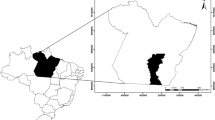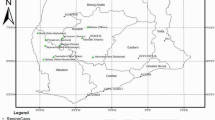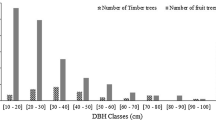Abstract
Poor establishment, due to loss of soil fertility, weeds and lack of appropriate shade, is a major constraint to replanting cacao on previously used land. Spathodea campanulata, Newbouldia laevis and Ricinodendron heudelotii planted as monospecific improved fallow and Terminalia ivorensis, T. superba and Antiaris toxicaria planted as a multispecies improved fallow and a natural tree fallow were assessed for their potential to facilitate cacao replanting in a randomized complete block design experiment. Simpson and Shannon diversity indices and species richness in the natural tree fallow were 0.6, 1.6 and 20, respectively, at 4 years after trial inception. The Multispecies and the R. heudelotii improved fallows had better height growth, crown development and light transmission characteristics, which are desirable for cacao shade. However, these were not comparable to S. campanulata or the natural tree fallow in terms of improving microsite topsoil pH, % organic carbon and % total nitrogen and site capture. Since optimum fallow period is shortened by growing fast-growing trees, the height growth rate >2.0 m per annum in all the treatments except N. laevis indicates the suitability of these species for improved fallow. The trees species showed different and complementary characteristics and from a standpoint of biodiversity conservation and the future floristic composition of the landscape the natural tree fallow with its diversity of tree species may be recommended as a rehabilitation technique to facilitate the replanting of cacao with a diverse overhead shade.




Similar content being viewed by others
References
Abbiw D (1990) Useful plants of Ghana: West African uses of wild and cultivated plants. Intermediate Technology Publications and the Royal Botanic Gardens, Kew, p 337
Ahenkorah Y, Halm BJ, Appiah MR (1987) Soil fertility, shade and cocoa nutrition experiments. Report. Cocoa Research Institute of Ghana, 1985/86:101–119
Ajayi OC, Kwesiga F (2003) Implications of local policies and institutions on the adoption of improved fallows in eastern Zambia. Agrofor Syst 59:327–336. doi:10.1023/B:AGFO.0000005233.32309.e4
Andersen JM, Ingram JSI (1993) Tropical soil biology and fertility: a handbook of methods, 2nd edn. CAB International, Wallingford
Anim-Kwapong GJ, Teklehaimanot Z (1995) Reclamation of degraded cocoa lands using Albizia zygia. Land Degrad Rehabil 6:109–123. doi:10.1002/ldr.3400060205
Beer J, Muschler R, Kass D, Somarriba E (1998) Shade management in coffee and cacao plantations. Agrofor Syst 38:139–164. doi:10.1023/A:1005956528316
Boni S (2006) Ghanaian farmers’ lukewarm reforestation: environmental degradation, the timber option and ambiguous legislation. Colloque International ‘les frontiers de la question foncière—At the frontier of land issues’. 17–19 May, Montpellier, France
Butterfield RP (1996) Early selection for tropical reforestation: a consideration of stability. For Ecol Manag 81:161–168. doi:10.1016/0378-1127(95)03649-0
Cleaver K (1992) Deforestation in the western and central African rainforest: the agricultural and demographic causes, and some solutions. In: Cleaver K, Munasinghe M, Dyson M, Egli N, Penker A, Wencelius F (eds) Conservation of west and central African rainforests. The World Bank/International Union for the Conservation of Nature, Washington DC, pp 65–78 351 pp
Deans JD, Diagne O, Nizinski J, Lindley DK, Seck M, Ingleby K, Munro RC (2003) Comparative growth, biomass production, nutrient use and soil amelioration by nitrogen-fixing tree species in semi-arid Senegal. For Ecol Manag 176:253–264
Fisher RF (1995) Amelioration of degraded rain forest soils by plantations of native trees. Soil Sci Soc Am J 59:544–549
Franzel S, Scherr SJ, Coe R, Cooper PJM, Place F (2002) Methods for assessing agroforestry adoption potential. In: Franzel S, Scherr SJ (eds) Trees on the farm: assessing the adoption potential of agroforestry practices in Africa. ICRAF, CABI Publishing, Nairobi, pp 11–35 197 pp
Gockowski J, Weise S, Sonwa D, Tchtat M, Ngobo M (2004) Conservation because it pays: shaded cocoa agroforestry in West Africa. Paper presented at the National Academy of Sciences in Washington DC on February 10, 2004 at a symposium titled ‘The Science behind cocoa’s benefits’
Gomez-Pompa A, Burley FW (1991) The management of natural tropical forests. In: Gomez-Pompa A, Whitmore TC, Hadley M (eds) Rainforest regeneration and management. Man and the biosphere series 6. UNESCO, Paris, pp 3–18
Hawthorne WD, Gyakari N (2006) Photoguide for the forest trees of Ghana. A tree-spotter’s guide for identifying the largest trees. Oxford Forestry Institute, UK, 432 pp
Horn HS (1976) Succession. In: May RM (ed) Theoretical ecology. Saunder, Philadelphia, pp 187–190
Hullugalle NR (1992) Amelioration of a highly degraded tropical Alfisol by planting. Changes in soil physical and chemical properties, 1989–91. Land Degrad Rehabil 3:141–152. doi:10.1002/ldr.3400030302
Kindt R, Coe R (2005) Tree diversity analysis. A manual and software for common statistical methods for ecological and biodiversity studies. World Agroforestry Centre (ICRAF), Nairobi
Kuuluvainen T, Pukkala T (1987) Effect of crown shape and tree distribution on the spatial distribution of shade. Agric For Meteorol 40:215–231. doi:10.1016/0168-1923(87)90060-8
McIntyre DS, Loveday J (1974) Bulk Density. In: Loveday J (ed) Methods for analysis of irrigated soils. Technical Communication No. 54 for the Commonwealth Bureau of Soils, pp 38–42
Ministry of Environment and Science (2002) National biodiversity strategy for Ghana. Ministry of Environment and Science, Accra
Mobbs DC, Cannell MGR (1995) Optimum tree fallow rotation: some principles revealed by modeling. Agrofor Syst 29:113–132. doi:10.1007/BF00704881
Ngobo M, Weise SF (2003) Species diversity in fallow lands of southern Cameroon—implications for management of man-made landscapes. Deutscher Tropentag, 8–10 October, 2003, Göttengen. Technological and Institutional Innovations for Sustainable Rural Development
Nkyi KA (1990) A survey of trees in the farming systems of the semi-humid forest zone of Ghana. M.Sc. Thesis, Oxford University, Oxford, UK
Norgrove L, Hauser S (2002) Measured growth and tree biomass estimates of Terminalia ivorensis in the 3 years after thinning to different stand densities in an agrisilvicultural system in southern Cameroon. For Ecol Manag 166:261–270. doi:10.1016/S0378-1127(01)00614-4
Olson JS (1963) Energy storage and the balance of producers and decomposers in ecological systems. Ecology 44:322–331. doi:10.2307/1932179
Omotosho TI (1975) Technical and research aspects of soil fertility and fertilizer use in Nigeria with special reference to cocoa. Phosphorus Agric 64:37–42
Philip (1994) Measuring trees and forest, 2nd edn. CABI Publishing, Wallingford, p 310
Quisumbing AR, Otsuka K, Suyanto S, Aidoo JB, Payongayong E (2001) Land, trees and women: evolution of land tenure Institutions in western Ghana and Sumatra. Research Report: 121. International Food Policy Research Institute, Washington DC
Ruf F, Schroth G (2004) Chocolate forests and monocultures: a historical review of cocoa growing and its conflicting role in tropical deforestation and forest conservation. In: Schroth G, da Fonseca GAB, Harvey CA, Gascon C, Vasconcelos HL, Izac AN (eds) Agroforestry and biodiversity conservation in tropical landscape. Island Press, Washington, pp 107–134
Sala OE, Chapin SF, Armesto JJ, Berlow E, Bloomfield J, Dirzo R, Huber-Sanwald E, Huenneke LF, Jackson RB, Kinzig A, Leemans R, Lodge DM, Mooney HA, Oesterheld M, Leroy Poff N, Sykes MT, Walker BH, Walker M, Wall DH (2000) Global biodiversity scenario for the year 2100. Bioscience 287:1770–1774
Acknowledgments
The authors are grateful to Messrs Owusu Afriyie, Kwabena Acheampong and Rev. Agyenim Boateng of the Agronomy/Soil Science Division of CRIG for providing technical assistance. This paper is published with the kind permission of the Executive Director of CRIG.
Author information
Authors and Affiliations
Corresponding author
Rights and permissions
About this article
Cite this article
Anim-Kwapong, G.J., Osei-Bonsu, K. Potential of natural and improved fallow using indigenous trees to facilitate cacao replanting in Ghana. Agroforest Syst 76, 533–542 (2009). https://doi.org/10.1007/s10457-008-9196-4
Received:
Accepted:
Published:
Issue Date:
DOI: https://doi.org/10.1007/s10457-008-9196-4




